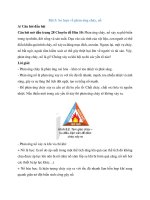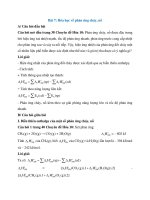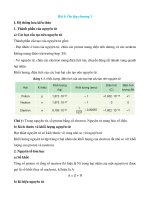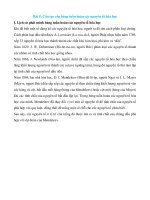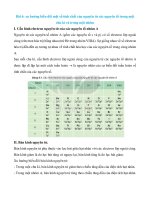bài tập luận LÝ THUYẾT DỊCH Answering the questions on theories
Bạn đang xem bản rút gọn của tài liệu. Xem và tải ngay bản đầy đủ của tài liệu tại đây (0 B, 32 trang )
Mã đề: 06
The assignment content has 3 parts
PART 1: Answering the questions on theories ( 20
points)
Question 1: What is the total translation?
Total translation is usually meant by ‘translation’ most of the time; that is,
translation in which all levels of the SL text are replaced by TL material.
Strictly speaking, “total” translation is a misleading term, since, though total
replacement is involved, it is not the replacement by equivalents at all levels.
According to Catford, in “total” translation, SL grammar and lexis are
replaced by equivalent TL grammar and lexis. This replacement entails the
replacement of SL phonology/graphology by TL phonology/graphology, but
this is not normally replaced by TL equivalents, hence there is no translation
at that level.
For use as a technical term, Total Translation may best be defined as:
Replacement of SL grammar and lexis by equivalent TL grammar and lexis
with consequential replacement of SL phonology/graphology by(non-
equivalent) TL phonology/graphology
(ii) Restricted translation is the replacement of SL textual material
by equivalent TL textual material, at only one level, that is translation
performed only at the phonological or at the graphological level, or at only
one of the two levels of grammar and lexis
Example 1: (Total translation)
- There is a legend about a bird which sings just once in its life, more
sweetly than any other creature on the face of the earth.
- À Có một truyền thuyết về một con chim chỉ hót một lần trong đời,
nhưng nó hót ngọt ngào hơn bất cứ loại chim nào trên trái đất này.
Example 2: (Total translation)
- Một bàn thắng, nhưng đằng sau nó là cả thiên đường và địa ngục,
và điều đó nói lên sự quyết liệt của V-League
- A goal with both the heaven and the hell behind proves the drastic
competition of V-League
It seems that this kind of translation is quite easy to realize, especially in the
example above; the translation versions can help readers to be able to
understand easily due to its fully clear content.
Question 2: What is the restricted translation ?
Restricted translation is the replacement of SL textual material by
comparable TL textual material at just one level, i.e. translation
accomplished only at the phonological or graphological levels, or at
only one of the two grammar and lexis levels.
Example: Khi mới bước chân về làm dâu, con sợ bu lắm”.
At the time to be your daughter-in-law, I was afraid of you, mother!
In this example, the word “bu” cannot be transferred from
Vietnamese into English because it is limited by cultural meaning.
The word “bu” is widely used by the Northern people in Vietnam to
address their male parent; it can be understood that is a/one way of
calling Father or dad, with a distinctive feature of a specific dialect.
PART 2: Working with the chosen texts
-- Choose 01 (or 02) English text(s) of about 500 words on the topic :
Tourism
(Analyse the context of the English text based on M.A.K Halliday’s
Model of Context or Dell Hymes’ Model of Context. Then translate
it (them) into Vietnamese.) ( 30 points )
SOURCE TEXT: VIETNAM PLANS RETURN OF TOURISM
AND HOSPITALITY AFTER COVID-19
/>
tourism-and-hospitality-after-covid-19.html
Vietnam plans return of tourism and hospitality after COVID-
19
NDO/VNA - After a bad year for business in 2020 as the COVID-19
pandemic shut down travel around the world, Vietnam's tourism
revenue fell even further this year. Plans were discussed by experts
at a forum to access the current state of the hospitality market and
map out a way towards a post-COVID-19 recovery.
Speaking at the "Vietnam Tourism and Hospitality – Managing in
Uncertain Times and the Way Forward”, Vice Chairman of the
Vietnam National Administration of Tourism Ha Van Sieu said the
tourism industry experienced a decline of 16% in domestic visitors
and 41% in tourism revenue in the first nine months of 2021,
compared to the same period last year.
“Accommodations, tour operators and travel services have been shut
down or closed temporarily while most international and domestic
flights have been cancelled or interrupted significantly due to travel
restrictions,” Sieu said.
“The percentage of occupied rooms in Vietnam’s accommodation
services was about 20% in 2020 and less than 10% in 2021.”
RMIT Head of Management Department from the School of
Business & Management Associate, Professor Nguyen Quang
Trung, observed that “the past two years have been challenging for
the hospitality and tourism landscape, leading to a really tough time
for hotels, restaurants and tourism establishments.”
In response to these uncertain times, InterContinental Hanoi
Landmark72 General Manager, Patrick Verove, shared proactive
plans which have helped the hotel overcome the difficulties.
“At a time of great uncertainty, we have ensured guests can trust us
for flexibility, cleanliness, safety and wellbeing priority,” Verove
said.
“Faced with temporary closures and low demand, we have identified
ways for operational changes to improve profitability, protect cash
flow, apply sophisticated digital solutions and train our staff with a
growth mindset.”
Capella Hotel General Manager, Christoph Strahm, emphasised the
hotel had taken various measures including speeding up the
adaptation of “state-of-the-art” technology and the implementation
of touchless services to deliver a modern guest experience.
“We have prioritised safety for both guests and staff by adopting
touchless services such as contactless check-in and check-out, inroom tablets, mobile key and press reader, among others,” Strahm
said.
When talking about the local tourism recovery plan, experts thought
about how the easing of restrictions can be managed, in line with the
economy getting back on track. The tourism sector is expected to
benefit from recovery measures and stimulus packages, allowing the
sector to return gradually.
Sieu urged tourism and hospitality companies to revise their
development strategies to adapt to new trends in tourism demands.
“Domestic tourism will surge, with a large proportion of travellers
favouring green destinations ranging from beaches, mountains,
forests, and national parks, followed by cuisine, culture, history and
entertainment,” he said.
“Tourism and hospitality companies should innovate and diversify
into new products which focus on wellness, safety, nature and
authentic experiences.”
Two other panellists at the forum included Frasers Suites Hanoi
General Manager, Sandy Ng, and Silk Path Hotels General Manager
and Chief Business Officer, Nguyen Thi Thanh Thủy.
Following the success of a previous event in January, the online
forum attracted close to 100 participants. They included local
authorities and business leaders in the tourism and hospitality
industry, as well as academics and students.
Text analysis
Language can only be understood in connection to its environment of
usage, and this concept is most clear in the language classroom,
where both spoken and written texts can not be read in isolation from
their settings of creation and circulation. The context of situation is
the environment of language viewed as texts particular texts and their
component components, according to SFL, whereas the context of
culture is the environment of language seen as a system its lexical
items and grammatical categories.
Halliday defines register as "a diversity of language, corresponding
to a range of situations," with situations interpreted through a
conceptual framework based on the terms "field," "tenor," and "mode."
The content or subject matter is referred to as the field. Our language
choices at school will vary based on factors such as the curriculum
area and the topic being covered. Language choices in science, for
example, will be very different from those in history. In every given
context, the tone relates to the roles we play (student, parent,
consumer, employee) and our interactions with others. The tenor will
be influenced by factors such as the participants' status, degree of
competence, age, ethnic origin, and gender. Language preferences
will differ depending on how well individuals know each other, how
frequently they meet, and how they feel about each other. The mode
refers to the communication channel being used: the mode and the
medium. Here, we are primarily concerned with the distinction
between the spoken and written modes, as well as the various roles
they play in the learning process. This is an essential factor for kids
as they transition from the oral language of the home and schoolyard
to the more dense and condensed language of the written mode at
school.
Field of the article: the article is about the tourism situation of
Vietnam in 2020. It is a summary of tourist statistic and explanation
of tourism problems after a year with sharp decline in 2020.
Tenor of the article: the author of the article is the Vietnamese
Government organization. Therefore, the receiver of this article is the
public and project planners working in tourism field in Vietnam. The
language used is more analytical and professional.
Mode of the article: the article was published via government press
release.
Translated Text:
Việt Nam có kế hoạch trở lại du lịch và khách sạn sau COVID-19
NDO / TTXVN - Sau một năm kinh doanh tồi tệ vào năm 2020 khi đại dịch
COVID-19 đóng cửa hoạt động du lịch khắp thế giới, doanh thu du lịch của
Việt Nam còn giảm hơn nữa trong năm nay. Các kế hoạch đã được các
chuyên gia thảo luận tại một diễn đàn nhằm tiếp cận tình trạng hiện tại của
thị trường khách sạn và vạch ra cách hướng tới sự phục hồi sau COVID-19.
Phát biểu tại Hội thảo “Du lịch và khách sạn Việt Nam - Quản trị trong thời
thế bất trắc và con đường tiến lên”, Phó Chủ tịch Tổng cục Du lịch Hà Văn
Siêu cho biết, ngành du lịch sụt giảm 16% về lượng khách nội địa và 41%
về doanh thu từ du lịch. 9 tháng đầu năm 2021, so với cùng kỳ năm trước.
“Các phịng nghỉ, cơng ty lữ hành và dịch vụ du lịch đã tạm thời ngừng
hoạt động hoặc đóng cửa trong khi hầu hết các chuyến bay quốc tế và nội
địa bị hủy hoặc gián đoạn đáng kể do hạn chế đi lại,” ơng Siêu nói.
“Tỷ lệ phịng có người sử dụng trong dịch vụ lưu trú của Việt Nam là
khoảng 20% vào năm 2020 và dưới 10% vào năm 2021”.
Ông Nguyễn Quang Trung, Trưởng khoa Quản trị của Trường Kinh doanh
& Quản lý RMIT, nhận xét rằng “hai năm qua đầy thách thức đối với ngành
khách sạn và du lịch, dẫn đến thời gian thực sự khó khăn đối với các khách
sạn, nhà hàng và cơ sở du lịch. ”
Trước những thời điểm khó khăn này, Tổng Giám đốc InterContinental
Hanoi Landmark72, Patrick Verove, đã chia sẻ những kế hoạch chủ động
đã giúp khách sạn vượt qua khó khăn.
“Vào thời điểm có nhiều bất ổn, chúng tơi đã đảm bảo rằng khách có thể tin
tưởng chúng tơi vì sự linh hoạt, sạch sẽ, an toàn và ưu tiên sức khỏe,”
Verove nói.
"Đối mặt với việc đóng cửa tạm thời và nhu cầu thấp, chúng tôi đã xác định
các cách thay đổi hoạt động để cải thiện lợi nhuận, bảo vệ dòng tiền, áp
dụng các giải pháp kỹ thuật số tinh vi và đào tạo nhân viên của chúng tôi
với tư duy phát triển."
Tổng Giám đốc Khách sạn Capella, ông Christoph Strahm, nhấn mạnh
khách sạn đã thực hiện nhiều biện pháp khác nhau bao gồm đẩy nhanh việc
điều chỉnh công nghệ “tiên tiến” và triển khai các dịch vụ không chạm để
mang lại trải nghiệm hiện đại cho khách.
“Chúng tơi đã ưu tiên sự an tồn cho cả khách và nhân viên bằng cách áp
dụng các dịch vụ khơng cần chạm như nhận và trả phịng khơng tiếp xúc,
máy tính bảng trong phịng, chìa khóa di động và đầu đọc báo, cùng nhiều
dịch vụ khác,” Strahm nói.
Khi nói về kế hoạch phục hồi du lịch địa phương, các chuyên gia đã nghĩ
đến việc làm thế nào để quản lý việc nới lỏng các hạn chế, phù hợp với nền
kinh tế đang đi đúng hướng. Ngành du lịch dự kiến sẽ được hưởng lợi từ
các biện pháp phục hồi và các gói kích thích, cho phép ngành này dần dần
quay trở lại.
Ơng Siêu kêu gọi các cơng ty du lịch và khách sạn sửa đổi chiến lược phát
triển của mình để thích ứng với các xu hướng mới về nhu cầu du lịch.
Ông nói: “Du lịch trong nước sẽ tăng mạnh, với một tỷ lệ lớn du khách ưa
thích các điểm đến xanh từ bãi biển, núi, rừng và vườn quốc gia, tiếp theo
là ẩm thực, văn hóa, lịch sử và giải trí.
“Các cơng ty du lịch và khách sạn nên đổi mới và đa dạng hóa thành các
sản phẩm mới tập trung vào sức khỏe, an toàn, thiên nhiên và trải nghiệm
đích thực.”
Hai tham luận viên khác tại diễn đàn bao gồm Tổng Giám đốc Frasers
Suites Hanoi, Sandy Ng, và Tổng Giám đốc Khách sạn Silk Path và Giám
đốc Kinh doanh, Nguyễn Thị Thanh Thủy.
Tiếp nối thành công của một sự kiện trước đó vào tháng 1, diễn đàn trực
tuyến đã thu hút gần 100 người tham gia. Họ bao gồm chính quyền địa
phương và các nhà lãnh đạo doanh nghiệp trong ngành du lịch và khách
sạn, cũng như các học giả và sinh viên.
-- Choose 01 (or 02) Vietnamese text(s) of about 700 words on the topic :
Tourism
Then translate it (them) into English. ( 20 points )
Source text: Phong Nha-Kẻ Bàng: Một trong 39
điểm đến năm 2022
/>
bang-mot-trong-39-diem-den-nam-2022-679502/
Phong Nha-Kẻ Bàng: Một trong 39 điểm đến năm
2022
Cửa hang Pygmy, hang động lớn thứ tư thế giới, nằm trong vùng lõi
VQG Phong Nha-Kẻ Bàng. (Ảnh: Mỹ Hạnh)
Để giúp những “tín đồ xê dịch” dễ dàng tìm kiếm câu trả lời cho câu
hỏi “đi đâu trong năm 2022 khi những đường biên giới đã mở lại”,
Tạp chí du lịch AFAR của Mỹ vừa công bố 39 điểm đến đáng giá để
trải nghiệm trong năm 2022. Di sản thiên nhiên thế giới Phong Nha,
Kẻ Bàng (Quảng Bình) của Việt Nam nằm trong danh sách này.
Theo AFAR, việc lặn sâu vào những hang động khổng lồ trong khu
vực Di sản Thiên nhiên Thế giới của UNESCO này đã trở nên dễ
dàng hơn bao giờ hết. Vườn Quốc gia Phong Nha-Kẻ Bàng, một địa
điểm địa chất nổi tiếng ở miền trung Việt Nam, đã luôn hấp dẫn
những người mê mạo hiểm kể từ năm 2013, khi Sơn Đng, hang
động lớn nhất hành tinh (có độ lớn đủ chứa một chiếc Boeing 747),
đã mở các tour du lịch nhiều ngày.
Từ năm 2022, dự kiến tour khám phá Hang Ba (được kỳ vọng sánh
ngang với tour hang Sơn Đoòng) sẽ được đưa vào khai thác. Hiện
tour này đang trong quá trình phát triển. Khi tham gia tour mới này,
du khách sẽ được thám hiểm xuyên qua 5 hang động với những
khoang đá vôi khổng lồ và những khối thạch nhũ treo ngược kỳ vĩ.
Những người tham gia thám hiểm sẽ được trải nghiệm đủ các kiểu di
chuyến như bơi, chèo ván, cắm trại, đi bộ xuyên rừng,
Nằm ở miền trung Việt Nam, tỉnh Quảng Bình, cách thành phố Đồng
Hới 50 km về phía Tây Bắc, cách thủ đô Hà Nội khoảng 500 km về
phía nam, Vườn Quốc gia Phong Nha-Kẻ Bàng 2 lần được UNESCO
vinh danh là Di sản Thiên nhiên Thế giới vào các năm 2003 và 2015.
Việc công nhận của UNESCO được dựa theo tiêu chí viii - giá trị địa
chất, địa mạo (2003); tiêu chí ix và x - sinh thái và đa dạng sinh học
(2015)...
Tạp chí AFAR dẫn lời chuyên gia Howard Limbert, người dẫn đầu
nhóm thám hiểm đã khám phá các hang động vào đầu những năm
1990: “Tôi đã muốn thiết kế chuyến tham quan này từ nhiều năm
nay. Hồi đó, mất 15 giờ để đi từ làng Phong Nha để đến được cụm
hang động. Nhờ có một con đường mới, quãng đường này có thể chỉ
mất từ 5 đến 6 giờ”.
Ơng Limbert nói thêm rằng, những nỗ lực tập thể để bảo vệ các hang
động (nhóm của ơng đã lập bản đồ hơn 500 hang động ở Việt Nam)
và thuê người dân từ cộng đồng đã làm giảm tỷ lệ khai thác gỗ bất
hợp pháp và thúc đẩy nhận thức về việc bảo tồn.
Theo ơng Limbert, Phong Nha-Kẻ Bàng có thể trở thành hình mẫu
cho các khu bảo tồn khác ở Việt Nam, bao gồm cả các khu dự trữ
sinh quyển mới được công nhận là Núi Chúa và Kon Hà Nừng.
Cùng với Phong Nha-Kẻ Bàng, AFAR cũng giới thiệu các điểm đến
hấp dẫn khác như vùng Arica và Parinacota (Chile), Abu Dhabi (Các
tiểu vương quốc Ả rập Thống nhất), Goa (Ấn Độ), Cairns (Australia),
Thị trấn Tokorozawa (Nhật Bản), Vườn quốc gia Abel Tasman (New
Zealand),… và 1 số điểm đến tại Mỹ như Thung lũng sông Nga,
California, Washington DC, Khu bảo tồn 10.000 đảo,...


